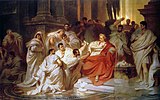ユリウス・カエサルの暗殺
| ユリウス・カエサルの暗殺 | |
|---|---|
| 内乱の1世紀中 | |
 The Death of Julius Caesar by Vincenzo Camuccini, c. 1805 | |
| 場所 | ポンペイウス劇場 |
| 座標 | 北緯41度53分43秒 東経12度28分37秒 / 北緯41.89528度 東経12.47694度 / 41.89528; 12.47694座標: 北緯41度53分43秒 東経12度28分37秒 / 北緯41.89528度 東経12.47694度 / 41.89528; 12.47694 |
| 日付 | 紀元前44年3月15日 |
| 標的 | ガイウス・ユリウス・カエサル |
| 攻撃手段 | 暗殺 |
| 犯人 | 60人以上の元老院議員 |
| Ringleaders | マルクス・ユニウス・ブルトゥス ガイウス・カッシウス・ロンギヌス デキムス・ユニウス・ブルトゥス・アルビヌス ガイウス・トレボニウス |
| テンプレートを表示 | |
ガイウス・ユリウス・カエサルは、紀元前44年3月15日にポンペイウス劇場において元老院議員らにより暗殺された。
カエサルへの権力集中により共和政ローマが弱体化していると主張するマルクス・ユニウス・ブルトゥス、ガイウス・カッシウス・ロンギヌス、デキムス・ユニウス・ブルトゥス・アルビヌスが率いる60から70人の元老院議員が関与した。しかし、カエサルの死にもかかわらず、暗殺に関与した者らは共和政の制度を回復させることは出来ず、帝政ローマのプリンキパトゥスにつながった。
暗殺に関与した人物

Most of the conspirators' names are lost to history and only about twenty are known. Nothing is known about some of those whose names have survived.[1] The known members are (leaders are highlighted in bold):
- Marcus Junius Brutus, former Pompeian,[2] the fifth and last of the assassins to wound Caesar, in the groin
- Gaius Cassius Longinus, former Pompeian,[2] the second assassin to strike Caesar, in the face
- Decimus Junius Brutus Albinus, former Caesarian,[3] the fourth assassin to land a wound on Caesar (a stab to the thigh)
- Gaius Trebonius, former Caesarian,[3] did not participate in the attack; kept Mark Antony outside the Theatre of Pompey while Caesar was being stabbed instead.[4]
- Lucius Tillius Cimber, former Caesarian,[3] the one responsible for setting the stage for the attack
- Publius Servilius Casca Longus, former Caesarian,[3] the one responsible for the first stab, to Caesar's shoulder
- Servius Sulpicius Galba, former Caesarian[3]
- Servilius Casca, former Caesarian,[3] brother of Publius Casca, the third assassin to strike Caesar, and the only one of the assassins to inflict a fatal wound on Caesar (a stab between the ribs)
- Pontius Aquila, former Pompeian[2]
- Quintus Ligarius, former Pompeian[2]
- Lucius Minucius Basilus, former Caesarian[3]
- Gaius Cassius Parmensis[5]
- Caecilius, former Pompeian[2]
- Bucilianus, former Pompeian, brother of Caecilius[2]
- Rubrius Ruga, former Pompeian[2]
- Marcus Spurius, former Pompeian[2]
- Publius Sextius Naso, former Pompeian[2]
- Petronius[5]
- Publius Turullius[5]
- Pacuvius Labeo[5]
Marcus Tullius Cicero was not a member of the conspiracy and was surprised by it. He later wrote to the conspirator Trebonius that he wished he had been "invited to that superb banquet" and believed that the conspirators should also have killed Mark Antony.[6]
ギャラリー
-
 The death of Caesar by Victor Honoré Janssens, c. 1690s
The death of Caesar by Victor Honoré Janssens, c. 1690s -
 Aftermath of the attack with Caesar's body abandoned in the foreground, La Mort de César by Jean-Léon Gérôme, c. 1859–1867
Aftermath of the attack with Caesar's body abandoned in the foreground, La Mort de César by Jean-Léon Gérôme, c. 1859–1867 -
 The Murder of Caesar by Karl von Piloty, 1865, Lower Saxony State Museum
The Murder of Caesar by Karl von Piloty, 1865, Lower Saxony State Museum -
 The Assassination of Julius Caesar by William Holmes Sullivan, c. 1888, Royal Shakespeare Theatre
The Assassination of Julius Caesar by William Holmes Sullivan, c. 1888, Royal Shakespeare Theatre - Mark Antony with the dead body of Caesar, painted by Bela Čikoš Sesija, before 1920
脚注
- ^ Epstein, David F. (1987). “Caesar's Personal Enemies on the Ides of March”. Latomus 46 (3): 566–570. JSTOR 41540686.
- ^ a b c d e f g h i Drumann 1906, pp. 632–640.
- ^ a b c d e f g Drumann 1906, pp. 627–632.
- ^ Broughton, pg. 315; Holmes III, pg. 343
- ^ a b c d Drumann 1906, pp. 640–642.
- ^ Ad Att. XIV 12
参考文献
- J. A. Crook, Andrew Lintott, Elizabeth Rawson (editors), The Cambridge Ancient History', Volume IX, The Last Age of the Roman Republic, Cambridge University Press, 1992.
- Balsdon, J.P.V.D. (1958). “The Ides of March”. Historia: Zeitschrift für Alte Geschichte 7 (1): 80–94. JSTOR 4434559.
- Drumann, W. (1906). P. Groebe. ed (ドイツ語). Geschichte Roms in seinem Uebergange von der republikanischen zur monarchischen Verfassung, oder: Pompeius, Caesar, Cicero und ihre Zeitgenossen. 3 (2nd ed.). Leipzig: Berlin, Gebr£uder Borntraeger. https://archive.org/details/geschichteromsi00groegoog/page/n644/mode/2up
- Epstein, David F. (1987). “Caesar's Personal Enemies on the Ides of March”. Latomus 46 (3): 566–570. ISSN 0023-8856. JSTOR 41540686.
- Horsfall, Nicholas (1974). “The Ides of March: Some New Problems”. Greece & Rome 21 (2): 191–199. doi:10.1017/S0017383500022397. ISSN 0017-3835.
- Parenti, Michael (2004). The assassination of Julius Caesar : a people's history of Ancient Rome. New Press. ISBN 1-56584-942-6. OCLC 56643456. https://archive.org/details/assassinationofj00mich
- Smith, R.E. (1957). “The Conspiracy and the Conspirators”. Greece & Rome 4 (1): 58–70. doi:10.1017/S0017383500015734. ISSN 0017-3835.
- Strauss, Barry S. (2015). The death of Caesar : the story of history's most famous assassination. ISBN 978-1-4516-6881-0. OCLC 913303337
- Yavetz, Zvi (1974). “Existimatio, Fama, and the Ides of March”. Harvard Studies in Classical Philology 78: 35–65. doi:10.2307/311200. JSTOR 311200.
- Dando-Collins, Stephen (2010). The Ides: Caesar's Murder and the War for Rome. Wiley. ISBN 978-0470425237
関連文献
- Sheldon, Rose Mary. Kill Caesar!: Assassination in the Early Roman Empire. Rowman & Littlefield, 2018.
外部リンク

- Account of the assassination from the historian Appian. Section 114 contains a list of conspirators.
- Suetonius, Life of Julius Caesar, includes an account of the plot
- The Assassination of Julius Caesar (The Ides of March, 44 B.C.E.) – video by YouTube channel Historia Civilis
Template:Julius Caesar











